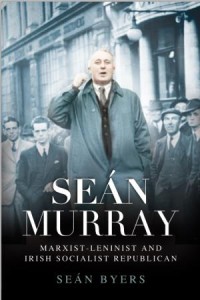Seán Murray. Marxist-Leninist and Irish Socialist Republican, Seán Byers
Irish Academic Press, Sallins 2015
ISBN: 978-07165-3297-2
Paperback, with illustrations in black and white, lists of abbreviations and plates, bibliography and index
228 pages
€22,45
Seán Murray and his role in twentieth-century Irish leftwing politics
With this book Seán Byers wants to give a proper place in historiography to Seán Murray (1898-1961), who was one of the founders and first general secretary of the Communist Party of Ireland (CPI). Besides his CPI activity, Murray was involved in many great historical events during his lifetime. He fought in the War of Independence and after that was an active anti-Treaty republican. He also was instrumental in the organization of the Irish volunteers that fought in the International Brigades during the Spanish Civil War but also remained a convinced Stalinist until his death in 1961 when Stalin’s crimes had long since been made public.
Byers starts his monograph with a thorough examination of the historiography of Irish communism, and Murray in particular. As Murray has not left us with much personal writings, Byers focuses his attention primarily on the public and professional side of Murray’s life. This biography is therefore primarily a political one.
Murray was born in the north of Ireland, from small farmer stock. After first describing shortly Murray’s youth and his involvement in the republican movement, Byers treats his involvement in the communist movement. In 1927 Murray became a student of the Lenin School in Moscow, showing himself a good student of Bolshevist propaganda and infiltration tactics, according to evaluation records. By that time, he already had ten years experience in leftwing political agitation.
In the first years of the 1930’s Murray c.s. had returned to Ireland from Russia and on orders of the Russian communist party strove to discredit the republican, trade union and socialist movements in Ireland, in favor of the ideology of communism. However, left republicanism and trade unionism were far too strong to make this sectarian approach a profitable strategy. The beginnings of communist intrigue and division amongst the movements of the left that can be seen in many European countries around this time, as a part of Stalinist geopolitic strategy, also shows itself here on the Irish scenery.
The 1930’s in Ireland saw an increasing tension between the left and the government, especially in Northern Ireland. Clashes between militant groupings increased, the fascist Blueshirts under leadership of Eoin O’Duffy emerged and the Catholic church initiated a ‘red scare’ throughout the island. Against this harsh tide Murray sought to found the new Communist Party of Ireland, while in the meanwhile trying to establish some degree of cooperation with the Irish Republican Army (IRA). This attempt eventually came to nothing sine the IRA was moving politically towards the right in this period, especially the lower officers and rank and file. Murray became general secretary of the young CPI. However, support for the communists remained marginal and Murray suffered frequent attacks, physically as well as verbally, from anti-communist militants, mostly from the ranks of the Church.
Despite strict Comintern policy not to engage in joint political cooperation with other leftwing movements, Murray saw the necessity to try somehow not to estrange the IRA and other leftwing parties from his CPI. With the Republican Congress in April 1934 however, it became clear the CPI stood alone and proved not being able to initiate a larger leftwing movement in which she could play a dominant and steering role. The IRA itself fell apart, with prominent leftwing IRA-men as Frank Ryan leaving the organization after a resolution that provided for an anti-imperialist congress was defeated. Thus, the IRA was moving away from labour politics. Murray came out of the congress damaged, and in a much less dominant position within the CPI than he hitherto had enjoyed.
In 1935 then, with the threat from nazi Germany increasing, the Comintern finally decided to follow a strategy of united popular fronts across Europe. Murray and his Irish communists were relieved, now this change of policy allowed them to implement a more viable strategy. Murray played a central role in organizing the recruitment and transport of Irish volunteers that went to Spain in defence of the Republic. Despite his sharp analysis of the nature of the Spanish conflict, he was blinded by his unconditional support for Stalin’s Soviet regime, thereby frequently relapsing in left-sectarian oratory to denounce Trotsky, trotskyist parties and the Spanish marxist POUM policital party. That a Stalinist dictatorship was, and would be, just as savage and criminal as a fascist one, was something Murray could not, or would not, comprehend.
As World War Two drew nearer, the CPI and Murray took a stance against both fascist and nazi politics on one side, and British and French imperialism on the other. With the tension between the Soviet Union and Nazi Germany increasing, the Comintern’s attention for European communist parties slackened, especially when they roamed the margins of the political spectre, as did the CPI. This allowed for Murray reviving his inner left-republican sympathies and aim for a renewed labour-republican front. This overt association led in turn to an estrangement of the protestant workers of northern Ireland from the CPI.
After being put aside by the Comintern leadership, and maybe even more important, removed from its payroll, Murray returned to Northern Ireland where he tried to get a foothold in the Communist Party of Northern Ireland (CPNI), without much succes. He was forced to return to the rank and file of the movement, selling hammer and sickle badges and communist party literature in the dockyards where he worked.
Whilst the CPI was sinking into oblivion in Dublin, Murray steadily worked his way back to the fore of communist politics in Northern Ireland, becoming the CPNI’s primary ideologue. As on the international scene Stalin departed and Krushchev came to power in the Soviet Union, Murray remained a staunch Stalin apologist and defender of the show trials of the 1930’s. In Northern Ireland however, he devoted the last years of his life to the writing of a manifesto for the CPNI.
Looking back at Murray’s life, full although he died relatively young, it becomes clear he has worked very hard all his life for the cause he thought was right. He grew out to be the main ideologist of the communist movement in Ireland for decades and ‘the brains of the communist party’. At the same time, he turned out to be an unchangeable Stalinist who refused to look at the inhherent weaknesses of communism as he propagated it.
Byers' work then, is all in all a laudable reconstruction of Murray’s political life and career, but it fails to dig deeper and grasp Murray’s true motives and intentions. His private life also is barely mentioned. Finally, Byers seems to be a bit too apologetic towards Murrays unrepentent Stalinism while the latter must have known of Stalin’s and his Soviet agents’ crimes and scheming during the decades he resided in international communist circles.
Wouter van Dijk

